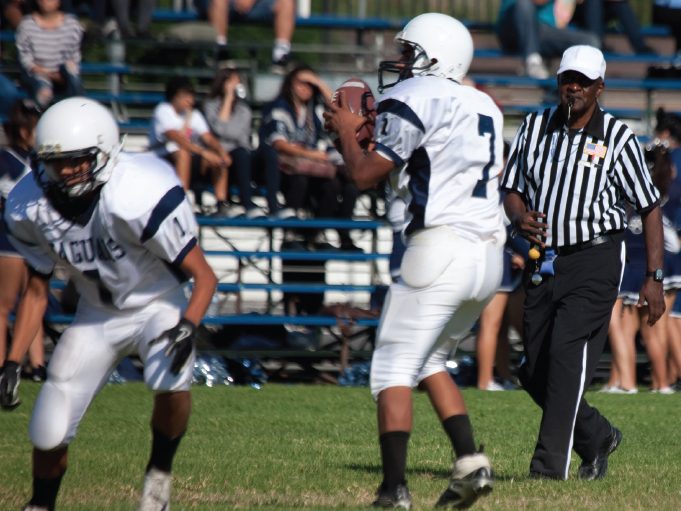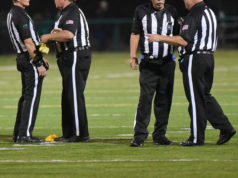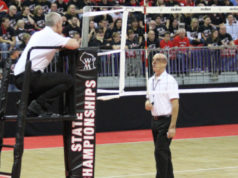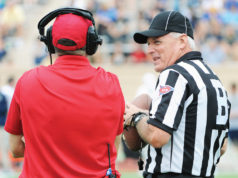More than one clinician has joked about officials who should have to buy a ticket to officiate a game because they mostly watch the game instead of their area of responsibility. At the prep level, ball-watching is perhaps a most common fault. All officials had their first exposure to football as a fan, so watching the game is a natural tendency; it takes will power and self-discipline to overcome that. By identifying the scenarios in which the inclination to watch the ball is the greatest, an official has a better chance of resisting that tendency.
Kickoffs.
The problem starts with the first play of the game. Since the first game was played in 1869, no one has ever reported a ball exploding in mid-air. There is no value in intensely watching the entire flight of the ball — nothing will happen in the air. It is beneficial for all officials to always know the approximate location of the ball and what is being done with it, but that can be accomplished with peripheral vision and without a direct and prolonged stare.
When the ball is kicked, all officials should know how it was kicked and the general direction it is taking. After that there are specific players to key on. There are a variety of ways to divide responsibilities both for while the ball is in the air and during the runback. The important thing is to have such a plan; it cannot be left to chance.
The first phase should be to watch as many of the initial blocks as possible in a specified area. What follows will vary depending on how the play develops. The number-one priority is ascertaining who has responsibility for getting the forward progress spot. An oft neglected aspect of kickoff coverage is supervising the untangling of players around the ball after the tackle. That is normally done by the umpire, but he may not be able to get to the dead-ball spot in time. On shorter returns, the referee may be the closest to the pile.
Pass plays.
One of the few similarities between pass plays and kickoffs is that the ball is in the air; it just doesn’t get airborne as quickly or as high as during a kick play. At the snap, the wing officials should watch their tackle to see if his block indicates a pass or a run. Pass blocking usually entails a one- or two-step drop. At that time, the official should shift his focus to his key.
A common mistake made by wing officials is watching the quarterback in the pocket to determine when and if he is going to throw the ball. While the official doesn’t have to be at the same yardline as the deepest receiver on his side of the field, he needs to be reasonably close, perhaps within 10-15 yards. The farther away the covering official is from the play, the more likely he will be straight-lined or his view otherwise blocked. On longer passes, if the official waits for the ball to be thrown before releasing downfield, he will not be able to get to the desired proximity.
Some officials on the sideline relax when all the receivers flow to the opposite side of the field. However if a receiver has to come back toward the passer to catch the ball and is contacted after catching it, the progress spot should be marked by the opposite wing while the near wing focuses on completion of the catch and any personal foul during the tackle.
Referees need to train themselves to keep their eyes on the quarterback until he is no longer in danger. Watching the flight of the pass will not reveal any useful officiating information. Even when the ball is thrown into an area where there are no eligible team A receivers, there are crewmates downfield who can provide that information. The ball’s destination is not immediately the referee’s concern. His part of the intentional grounding determination is to decide if the throw is made under duress. Without a pressured throw, there cannot be a foul for grounding the ball. It could be an egregious error if the referee is watching the ball in mid-air while the passer is being roughed by the defense.
Running plays.
On runs to the opposite side, a wing official should focus on cleaning up behind the play, especially on any action against the quarterback after the handoff. Attempting to watch the ball on those plays is doubly futile. Not only does the ball not need any particular attention from the opposite side, but the view of the ball will almost certainly be blocked by the runner’s body, if not other players.
On runs to the near side, the wing official should focus on blocks in front of the runner — the point of attack. To do that the official must look beyond the path of the runner into the line. Conspicuous acts such as a takedown (tackle) or arm encirclement accompanied by forceful impetus or the prolonged grabbing of a jersey or an arm, are relatively easy to spot. Other forms of restriction such as taking out an opponent’s feet, spinning or turning him around or causing him to fall in an unnatural direction are more difficult to discern and generally cannot be detected with peripheral vision while watching the ball.
Punts.
Although the ball is in the air for a substantial amount of time during a punt, most officials are disciplined enough to not watch the ball. Perhaps it’s the realization that a crew of five is extremely short-handed when covering a punt. Umpires who try to watch the ball are inadvertent targets for linemen who abruptly turn to run downfield.
The referee has good reason to watch the ball if it heads toward a sideline, but his primary responsibility is observing the kicker. Punted balls that go out of bounds in flight must be lined up by the referee in conjunction with the wing official or back judge. However, the referee cannot watch the flight of the ball at the expense of missing contact on the kicker.
What's Your Call? Leave a Comment:
Note: This article is archival in nature. Rules, interpretations, mechanics, philosophies and other information may or may not be correct for the current year.
This article is the copyright of ©Referee Enterprises, Inc., and may not be republished in whole or in part online, in print or in any capacity without expressed written permission from Referee. The article is made available for educational use by individuals.


















